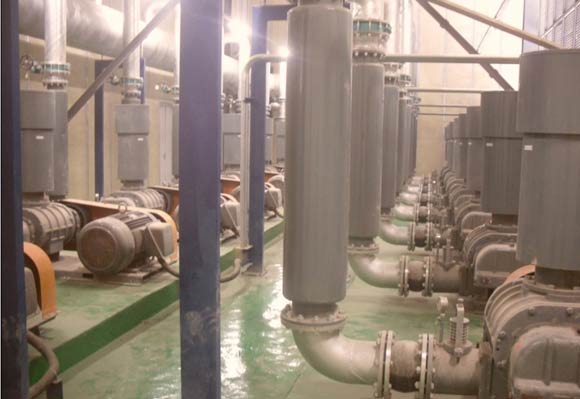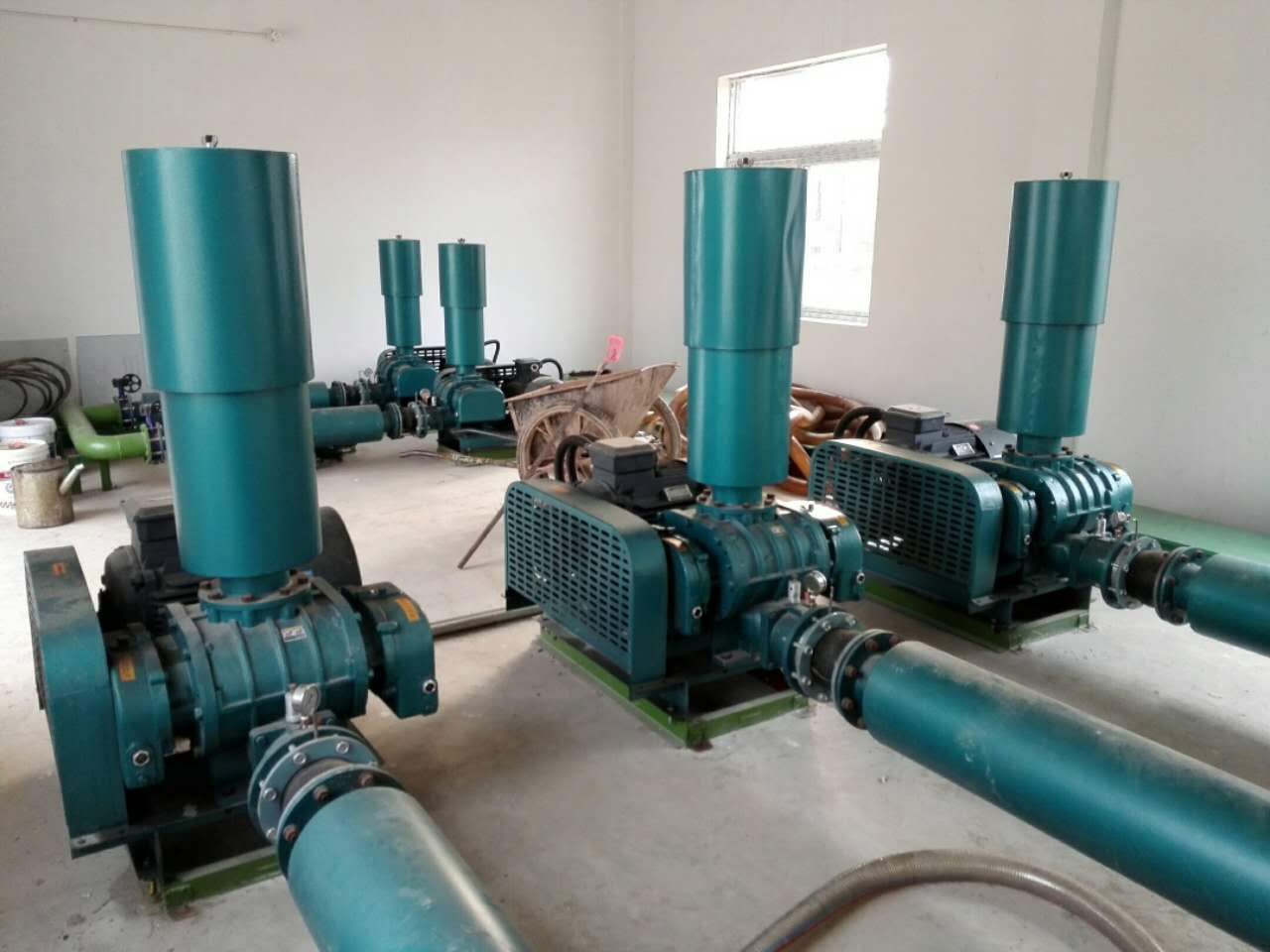The role of the oxidation fan is to accelerate the oxidation rate. For example, the oxidation fan of the power plant oxidizes calcium sulfite into calcium sulfate. Calcium sulfite can be oxidized under normal conditions, but in order to improve production efficiency, it is necessary to increase the oxygen supply and promote oxidation. Generally, roots blowers are used more. Roots blower is a positive displacement fan. The air volume transported is proportional to the number of revolutions. The gas is transported from the suction side to the discharge side by using the "meshing" of the impeller. The pressure is high.
? Product details:
The oxidation roots blower is located in the oxidation blower room to provide sufficient oxidation air for the slurry in the slurry tank of the absorption tower. It is isolated by the manual switching valve of the spear shaped air nozzle. When isolating, the spray pipe can be flushed by opening the manual switch valve of the flushing water pipe. Oxidation roots blower is also a piece of roots blower. Each roots blower includes lubrication system, inlet and outlet silencers, inlet air ducts, as well as roots blower accessories, valves, flanges, motors, couplings, common base of motors and fans, local control cabinet, coolers, etc.
? Desulfurization oxidation roots blower model parameters :| Model (xqs Roots blower) | Air volume range (m?/min) | Motor power range (kw) | Outlet diameter | Fan weight (KG) | Pressure range | Voltage |
| Sr50 | 0.65-2.13 | 0.75-4 | DN50 | 87-119 | 9.8kp-58.8kp | 380V |
| Sr65 | 0.94-3.00 | 0.75-5.5 | DN65 | 98-145 |
| Sr80 | 2.34-5.22 | 2.2-7.5 | DN80 | 156-200 |
| Sr100 | 3.25-8.05 | 2.2-15 | DN100 | 190-297 |
| Sr125 | 5.35-11.7 | 3-18.5 | DN125 | 285-401 |
| Sr150 | 10.37-27.15 | 7.5-45 | DN150 | 471-706 |
| Sr175 | 19.65-38.67 | 11-75 | DN175 | 601-1090 |
| Sr200 | 27.65-57.14 | 15-90 | DN200 | 975-1490 |
| Sr-225 | 32.95-70.56 | 18.5-110 | DN225 | 1080-1845 |
| Sr-250s | 35.83-76.72 | 18.5-132 | DN250 | 1115-1936 |
| Sr-250/300 | 61.4-114.8 | 30-160 | DN250/300 | 1843-2761 |
| Sr-300L/300L1 | 104.1-183.6 | 37-200 | DN300 | 2031-3440 |
| Sr-350/350L | 105.5-226 | 37-280 | DN350 | 3870-5700 |
? Application of Roots blower :
Due to the deterioration of the environment, haze has become increasingly serious. In recent years, the environmental awareness of the whole people has become stronger and stronger, the government has paid more attention to the environmental protection industry year by year, and the demand for oxidized Roots blowers is also increasing, which are mainly used for sewage treatment, urban garbage incineration, industrial high concentration organic wastewater treatment, efficient bag dust removal, thermal power plant flue gas desulfurization and other systems are inseparable from oxidized Roots blowers.
Real picture of oxidation roots blower factory :
? Precautions for installation of oxidation roots blower :
1. In the installation stage, pay attention to the cleanness of the pipe orifice, and prohibit welding slag and sundries from entering the Roots blower, otherwise the blades may be damaged. There is a sentence in the general manufacturer's instructions that "the size of medium particles shall not exceed half of the small working clearance of the fan". The working clearance is very small, and the sundries are far larger than this size. In particular, serious equipment failure will occur when the rebar head enters the interior.
2. During commissioning, generally run for a short time with no load, generally 30 minutes. Empty load means to open the vent valve (pressure relief valve), and then close the pressure relief valve to operate with load after the machinery is OK.
3. For the second stage Roots oxide blower, an intercooler is set, that is, the air comes out of the first stage blower and passes through the intercooler before entering the second stage Roots oxide blower to reduce the air temperature at the inlet of the second stage blower. If the cooling effect of the intercooler is not good, the temperature of the second stage oxidation blower will be higher, Therefore, it is necessary to ensure that the cooling water of the intercooler is unblocked and has sufficient flow during commissioning and operation. The intercooler is generally controlled below 40 degrees. In some projects, pressure gauges are installed in the cooling water pipeline. In fact, what is concerned is the flow, so water meters or flow direction indicators can be used.
4. Noise. The noise problem of oxidation roots blower is a common problem in most domestic power plants. In order to reduce the noise, a sound insulation cover is often set outside the blower. However, the entrance and exit are outside the acoustic enclosure, which cannot fundamentally solve the noise problem. The inlet is equipped with a silencer, and the size of the silencer has a direct impact on the noise level. For the large capacity oxidation fan, the noise at the cooler is also obvious, and it is placed outside the acoustic enclosure. A power plant has conducted thermal insulation treatment on the intercooler, which has a certain effect on the sound insulation, but the effect is not ideal.
5. The pressure of the oxidation fan is rated on the nameplate of each oxidation fan. Its pressure rise depends on the back pressure of the system connected to the exhaust port. In actual operation, its pressure generally depends on the liquid level and slurry concentration of the absorption tower. If the distance between the liquid level and the mouth of the oxidation lance is 10 meters and the slurry density is 1150kg/m3, the oxidation fan should overcome the resistance of 115kPa slurry. It is forbidden to adjust the opening of the outlet valve to adjust the pressure and flow.
? Attention to gasification roots blower :
1. The inlet air temperature shall not exceed 35 ° C.
2. The content of solid particles in the gas shall not exceed 100m3, and the maximum particle size shall not be greater than the specified minimum working reaction.
3. The coal tar index of gas must meet the requirements of TJ28-78 in the design of urban gas specification.
4. The bearing temperature shall not exceed 85 ° C.
5. The maximum temperature of lubricating oil shall not exceed 65 ° C.
6. The pressure indicated on the pressure gauge of the fan shall not exceed the pressure rise range specified in the manual, otherwise it must be stopped, and check whether the air inlet is blocked in the system, whether the air inlet valve and exhaust valve are blocked and closed. If the static moving parts on the fan are rubbed, wait for other problems and take appropriate measures. Related labels: Oxidation Roots blower , Roots Blower 







